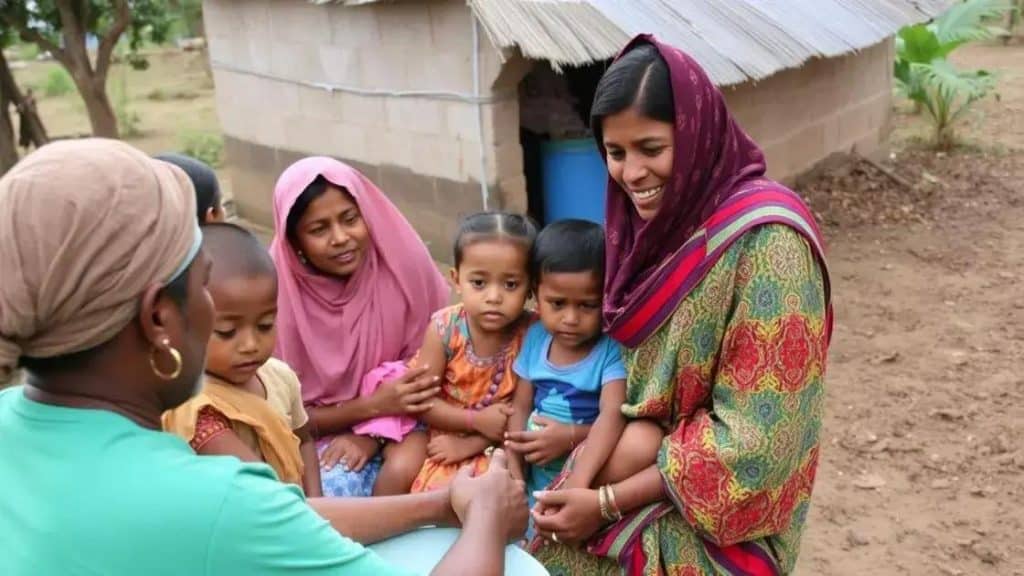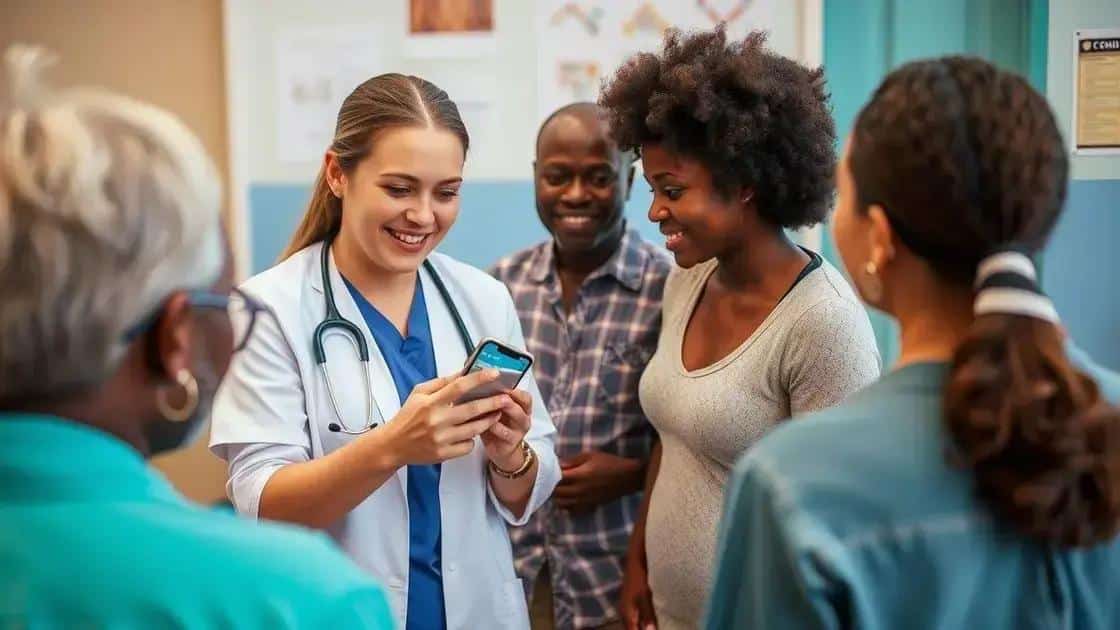Healthcare assistance for vulnerable communities: A game changer

Healthcare assistance for vulnerable communities is enhanced through collaborative efforts between NGOs and government initiatives, utilizing innovative solutions like mobile clinics and school-based health centers to ensure access to essential services.
Healthcare assistance for vulnerable communities plays a vital role in addressing disparities in access to medical services. Have you ever considered how these efforts directly impact individuals’ lives? This article explores key initiatives making a difference.
Understanding the challenges in healthcare access
Accessing healthcare can be difficult for many communities, particularly those that are vulnerable. Understanding these challenges is the first step toward creating effective solutions. With a focus on healthcare assistance for vulnerable communities, we can address issues that impact access.
Key barriers to healthcare access
Several barriers prevent individuals from receiving the care they need. These include:
- Financial constraints: Many families struggle to afford healthcare services, leading to unmet medical needs.
- Geographic limitations: Rural areas often lack nearby healthcare facilities, forcing long travel distances.
- Cultural differences: Language barriers and cultural misunderstandings can hinder effective communication between patients and providers.
- Lack of education: A limited understanding of healthcare systems can prevent individuals from seeking necessary care.
Combating these challenges requires innovative solutions. Community health workers, for instance, play a crucial role in bridging the gap. They connect vulnerable populations with the resources and information needed to navigate healthcare options effectively.
Collaborative efforts
Additionally, collaboration among community organizations, government agencies, and healthcare providers is essential. Many organizations are working together to share resources and information. This helps create programs that specifically address the unique needs of vulnerable communities.
Fundamentally, raising awareness about available resources can greatly improve access to healthcare. Educating communities empowers individuals to seek assistance and understand their care options. Outreach programs and informational workshops are vital in providing this support.
In conclusion, understanding the challenges in healthcare access is key to finding solutions. By addressing financial barriers, geographic limitations, and cultural differences, we can enhance the quality of life for vulnerable populations.
Innovative solutions for community healthcare
Finding innovative solutions for community healthcare is essential for improving access and quality of care for vulnerable populations. With evolving technologies and collaborative efforts, new strategies are being implemented to meet the needs of these communities.
Telehealth services
One notable solution is the rise of telehealth services. These digital platforms allow patients to connect with healthcare providers remotely, which is particularly useful for those in rural areas. By reducing the need for travel, telehealth can significantly increase access to necessary medical advice and treatment.
- Convenience: Patients can schedule appointments from their homes.
- Cost-effective: Telehealth can be more affordable than in-person visits.
- Increased reach: This technology allows healthcare services to extend to underserved areas.
This innovative approach has transformed how patients receive care, especially during challenging times such as a pandemic, where physical distancing is necessary.
Mobile health clinics
Another effective solution is the use of mobile health clinics, which travel to various locations to provide healthcare services. These clinics are particularly beneficial for low-income and rural communities that lack nearby healthcare facilities.
Mobile clinics can offer a wide range of services, such as immunizations, screenings, and educational resources. By bringing healthcare directly to those in need, these initiatives bridge the gap in access.
Working hand-in-hand with local organizations, mobile clinics can tailor services to meet specific community needs. This creates a more personalized approach to healthcare that resonates with the population.
As we explore these innovative solutions, it’s clear that creativity and collaboration will play key roles in addressing the challenges faced by vulnerable communities and ensuring that all individuals receive the healthcare they deserve.
The role of technology in improving assistance

The role of technology in improving assistance for vulnerable communities cannot be overlooked. Technology has the power to transform healthcare delivery, making it more efficient and accessible for those in need.
Digital health records
One major advancement is the implementation of electronic health records (EHRs). These systems enable healthcare providers to store and share patient information securely and efficiently. As a result, patients receive better continuity of care.
- Easy access: Healthcare professionals can quickly access patient histories, allergies, and medications.
- Improved communication: EHRs facilitate better communication between various healthcare providers.
- Data accuracy: Reduces errors caused by illegible handwriting or miscommunication.
With EHRs, patients benefit from a more coordinated approach to their healthcare, enabling more timely interventions.
Mobile applications
Mobile applications are another innovative tool. They provide valuable resources and information directly to users’ smartphones or tablets. Many apps can connect patients with healthcare providers or educational materials.
These applications often allow users to:
- Track health metrics: Patients can monitor their symptoms, medication schedules, and appointments.
- Access telehealth services: Patients can consult with doctors from the comfort of their homes.
- Receive reminders: Automated reminders help patients stay on top of their healthcare routines.
Mobile apps empower patients to take charge of their health, encouraging proactive management and promoting better health outcomes.
Technology also plays a crucial role in community outreach. Social media and online platforms can help raise awareness about available healthcare services and programs. This increases the visibility of resources for vulnerable populations.
Encouraging community members to engage with these technological tools can create a more informed and empowered populace. Ultimately, the integration of technology into healthcare assistance is essential to meet the needs of vulnerable communities.
Collaborative efforts: NGOs and government initiatives
Collaborative efforts between NGOs and government initiatives are essential in addressing healthcare challenges for vulnerable communities. These partnerships leverage resources, expertise, and networks to provide comprehensive support and care.
Shared goals and resources
When NGOs work alongside government agencies, they can combine their strengths to tackle healthcare issues more effectively. NGOs often have the grassroots connections and understanding of community needs, while governments can provide funding and wider reach.
- Resource sharing: NGOs can access funding and logistical support from government programs.
- Knowledge exchange: Collaboration fosters a greater understanding of best practices in healthcare.
- Unified messaging: A coordinated approach enhances awareness and encourages community engagement.
For instance, during health crises—such as pandemics—these partnerships can mobilize quickly, providing vaccines, information, and resources to communities in need.
Successful programs and initiatives
Many successful programs demonstrate how NGOs and governments can effectively work together. Immunization drives are a prime example. NGOs often conduct outreach and education, while government health departments supply vaccines and funding.
Another successful initiative is mobile health clinics that rely on collaboration. NGOs manage these clinics, ensuring they reach vulnerable populations, while local governments provide necessary permits and support.
These partnerships often lead to improved health outcomes, as they create a more integrated healthcare system. When NGOs and government bodies unite, they can create greater awareness and access to essential health services.
Engaging communities in these initiatives is key to their success. When individuals feel empowered and informed, they are more likely to participate and seek assistance. With the right collaboration, communities can thrive and overcome healthcare barriers.
Case studies of successful healthcare programs
Examining case studies of successful healthcare programs reveals valuable insights into effective strategies for reaching vulnerable communities. These examples show how targeted initiatives can lead to improved health outcomes.
Program 1: Mobile Health Outreach
A notable example is a mobile health outreach program that operates in rural areas. This initiative brings healthcare directly to communities with limited access. The program offers services like screenings, vaccinations, and health education.
- Accessibility: By traveling to remote locations, the mobile clinic helps bridge the gap for individuals who may otherwise be unable to receive care.
- Community engagement: Local health workers build trust and foster relationships, encouraging individuals to prioritize their health.
- Diverse services: The program adapts services based on community needs, focusing on relevant health issues.
This approach not only enhances access but also empowers communities to take charge of their health.
Program 2: School-based Health Centers
Another effective initiative is the establishment of school-based health centers. These centers provide students with essential health services, such as mental health support, physical exams, and nutritional counseling.
Key features include:
- Convenient access: By locating services within schools, students can easily seek help without missing class time.
- Early intervention: Addressing health issues early prevents them from becoming more serious.
- Parental involvement: Educating families about health encourages a supportive home environment.
These centers play a vital role in promoting overall student well-being.
Both case studies highlight the importance of community involvement and adaptability in program design. By understanding and responding to the specific needs of vulnerable populations, healthcare programs can achieve remarkable success.
In conclusion, the collaboration between NGOs and government initiatives holds great promise for enhancing healthcare access in vulnerable communities. Through innovative solutions like mobile health clinics and school-based health centers, significant strides can be made toward addressing healthcare disparities. The case studies highlighted demonstrate the effectiveness of these programs, showing that when resources are pooled and tailored to community needs, positive health outcomes are achievable. It is essential for these collaborative efforts to continue evolving, ensuring that all individuals receive the care they deserve.
FAQ – Frequently Asked Questions about Healthcare Assistance for Vulnerable Communities
What role do NGOs play in healthcare assistance?
NGOs provide crucial support by understanding community needs, offering services directly, and collaborating with government programs to enhance healthcare accessibility.
How do mobile health clinics improve access to care?
Mobile health clinics travel to underserved areas, delivering essential services like screenings and vaccinations directly to those who need them most.
What benefits do school-based health centers offer?
School-based health centers provide students with convenient access to healthcare services, addressing issues early and fostering a supportive environment for health education.
How can technology enhance healthcare initiatives?
Technology, such as digital health records and mobile apps, improves communication and access to health resources, helping individuals manage their healthcare more effectively.





